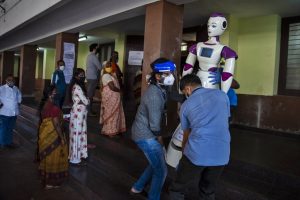India’s COVID-19 crisis is showing signs of easing somewhat. From a peak daily caseload of over 98,000 in September, new coronavirus infections have declined to a daily average of 12,806 over the past month. Daily new infections have, in fact, witnessed a decline of 37 percent since mid-January.
However, the situation in two states, Maharashtra and Kerala, remains worrying.
As on February 17, Maharashtra had a total tally of 2,076,093 cases of COVID-19, the highest in the country, with 38,013 active cases. Some 4,878 new infections were reported over a 24-hour period that day. Kerala leads the country with regard to the number of active cases (60,803) and new infections (4,892) and with 1,016,848 confirmed cases, as the second largest cumulative caseload.
Together the two states account for 72 percent of India’s active case count.
COVID-19’s impact on Kerala has been disproportionate to the size of its population. Although the state accounts for 2.6 percent of India’s population, its total tally of COVID-19 infections is roughly 9 percent of India’s cumulative caseload.
Once hailed for its success in containing the spread of novel coronavirus, Kerala has gained the dubious distinction in recent months of reporting the highest number of daily cases in the country. How did it reach this situation?
It was in Kerala that India’s first case of COVID-19 was detected on January 30 last year. For several months thereafter, while the rest of India was grappling with surging numbers of coronavirus infections, Kerala recorded just a few cases. Until the first week of June, its daily infections remained below 100; this, at a time when Delhi and neighboring Tamil Nadu were reporting over 1,000 new cases a day and Maharashtra‘s daily count exceeded 2,000, and despite hundreds of thousands of Kerala’s workers living and working in other parts of India and abroad returning home.
Kerala’s success in containing the coronavirus during those early months was applauded worldwide. The state government was praised for its systematic response to the pandemic; patients were swiftly isolated and treated, quarantining was strictly enforced, and contact tracing undertaken robustly. Kerala’s success with containing the virus was also attributed to its health infrastructure, which had been built over the decades by successive governments in the state.
Infections began to rise in July but it was only in September that alarm bells began ringing. Coronavirus infections began to rise sharply and it was increasingly evident that Kerala’s fight against the coronavirus was falling apart. From an average daily count of around 2,000 in early September the numbers rose to nearly 8,000 in the last week of that month and peaked at 10,606 on October 7. In June, Kerala accounted for 1 percent of India’s total tally of COVID-19 cases; by October, this had increased to 10 percent.
In the months since, although Kerala has brought down daily infection,s the numbers remain high and the state’s COVID-19 caseload is enormous. So where did Kerala trip up?
Between late August and early September, Kerala celebrated Onam. Then came Christmas and New Year. With an eye on elections, the government avoided displeasing voters; it did not impose restrictions on mass gatherings or celebrations.
This has been the case with elections, too. Keralites are highly politically conscious and elections draw enthusiastic participation of voters in rallies and processions. Local body elections were held in December and every stage of the process, from campaigning to voting, saw huge crowds participating in utter disregard of COVID-19 protocols. Campaigning for state assembly elections in April is underway now and political parties across the spectrum are holding rallies and processions where few wear masks or observe social distancing norms.
But other states have also held elections in recent months and a similar disregard for COVID-19 rules was visible there as well. Still, infections didn’t soar there as it has in Kerala.
Experts believe that Kerala may be “a victim of its own success.” Since the state was diligent in containing the virus in the early stages, only a small section of the population developed immunity. Indian Council of Medical Research surveys have revealed that sero-prevalence in Kerala has been “consistently and significantly lower” than in the rest of India. In August, the national average sero-prevalence was around 7 percent compared to 1 percent in Kerala. The latest figures show that while sero-prevalence in Kerala has increased to 11.6 percent, it is still way below the national average of 22 percent.
Unlike in other states, where a large number of people were exposed to the virus and developed immunity, Kerala’s population remains vulnerable.
But there are rays of hope amid the gloomy situation in Kerala. Its case fatality rate (i.e. the percentage of infected people who lost their lives to COVID-19) is just 0.4 percent, among the lowest in the country. Kerala has done a good job of ensuring the recovery of its COVID-19 patients.
































